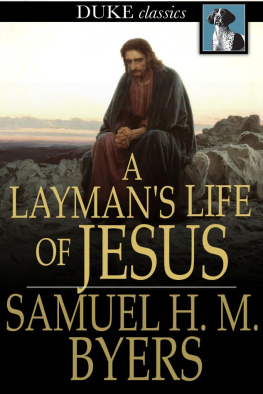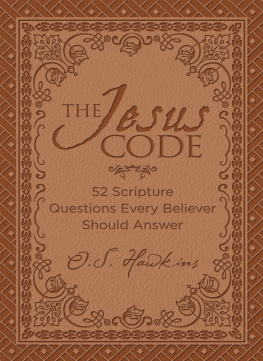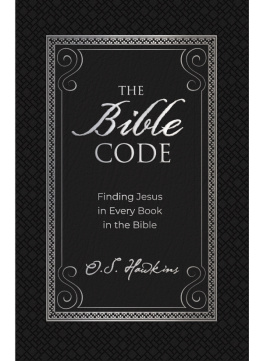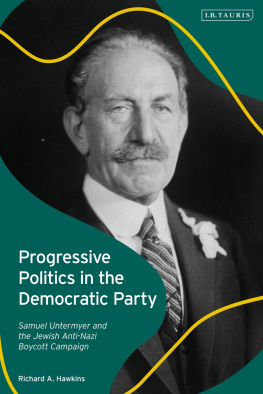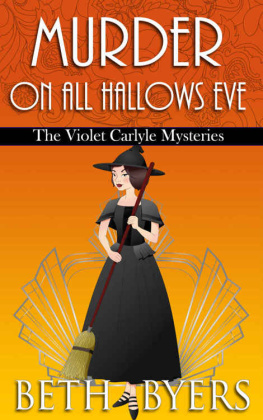Samuel Hawkins Marshall Byers - A laymans life of Jesus
Here you can read online Samuel Hawkins Marshall Byers - A laymans life of Jesus full text of the book (entire story) in english for free. Download pdf and epub, get meaning, cover and reviews about this ebook. year: 2012, genre: Art. Description of the work, (preface) as well as reviews are available. Best literature library LitArk.com created for fans of good reading and offers a wide selection of genres:
Romance novel
Science fiction
Adventure
Detective
Science
History
Home and family
Prose
Art
Politics
Computer
Non-fiction
Religion
Business
Children
Humor
Choose a favorite category and find really read worthwhile books. Enjoy immersion in the world of imagination, feel the emotions of the characters or learn something new for yourself, make an fascinating discovery.
- Book:A laymans life of Jesus
- Author:
- Genre:
- Year:2012
- Rating:4 / 5
- Favourites:Add to favourites
- Your mark:
- 80
- 1
- 2
- 3
- 4
- 5
A laymans life of Jesus: summary, description and annotation
We offer to read an annotation, description, summary or preface (depends on what the author of the book "A laymans life of Jesus" wrote himself). If you haven't found the necessary information about the book — write in the comments, we will try to find it.
A laymans life of Jesus — read online for free the complete book (whole text) full work
Below is the text of the book, divided by pages. System saving the place of the last page read, allows you to conveniently read the book "A laymans life of Jesus" online for free, without having to search again every time where you left off. Put a bookmark, and you can go to the page where you finished reading at any time.
Font size:
Interval:
Bookmark:

First published in 1912
ISBN 978-1-62013-111-4
Duke Classics
2013 Duke Classics and its licensors. All rights reserved.
While every effort has been used to ensure the accuracy and reliability of the information contained in this edition, Duke Classics does not assume liability or responsibility for any errors or omissions in this book. Duke Classics does not accept responsibility for loss suffered as a result of reliance upon the accuracy or currency of information contained in this book.
Every book should have a purpose. The object of this little volume isto try and harmonize, in a sense, and bring nearer to us, the story ofthe Master. It is free from the fog of creed, and the simple pictureof the Times and the Man may help to waken new interest, especiallywith the young in the greatest tale of the world.
H. S. M. B.
Des Moines, Sept. 3, 1912.
One of the beauty spots of the world, a couple of thousand years ago,was the little land of Galilee, in upper Palestine. That was a landfor poets and painters.
Lonesome, deserted, and little inhabited as it seems now, there was atime when this little paradise of earth had many people and manyhandsome cities. In my time, says Josephus, there were not lessthan four hundred walled towns in Galilee. Nature, too, was lavish inits gifts to this little land. There were green valleys there,picturesque mountains, clear blue lakes, running brooks, and grassyfields. An Eastern sun shone on the province almost all the time.There was no winter there. Like a diamond in the very heart of thisbeautiful land sat the town of Nazareth, The Flower of Galilee.Close by the village were the hills that fenced in the upper end ofthe plain of beautiful Esdralon. Figs grew there at Nazareth, andoranges, and grapes luscious and bountiful as nowhere else. Theflower-lined lanes stretched from the village clear down to the bluelake of Galilee, only a dozen miles or so away. It must have been adelight to live in a climate so delicious, in a land so lovely.
It all belonged to Rome then, as did the whole country knownas Palestine. The Romans had divided the land into threeprovinces,Galilee, Samaria, and Judea, with its splendid city ofJerusalem, then one of the noted capitals of the world. Governors orkings were appointed for these three provinces by the emperors atRome; they were usually Orientals.
Just now two sons of Herod the Great, oftener known as the splendidArab, are ruling there. The one named Herod is at Jerusalem; hisbrother Antipater, or Herod Antipas, is governing little Galilee inthe north end of Palestine. Like many another Oriental king he is anidle, luxurious, dissipated, and corrupt ruler.
There is yet another brother of these two kings. His name is Philip,and he lives in Rome. He has a very beautiful wife, who some day is tobring great trouble on the world, for Antipater will yet desert hisGalilean queen and marry this Roman beauty.
It is all in the time of the great Augustus that we are talking ofnow. In Rome it is called the Golden Age. It is not quite that inPalestine. Yet the worlds greatest era is just beginning there. Inhow small a territory the worlds greatest deeds are about to beenacted! Palestine, taken all together, did not make much of a countryin area; many of the states in the American union have more squaremiles, but all the nations in the world combined have no such history.Palestine is a strip of territory reaching along the Mediterranean forone hundred and fifty miles on one side, and along the Arabian deserton the other. It is hardly over sixty miles across. It istopographically of the most diversified character. It has somebeautiful valleys and purling streams; it has mountains, too, loftyand desolate, and its principal lakes are almost a thousand feet belowthe level of the sea. The whole land is cut in two lengthwise by theJordan river, the most peculiar, the most rapid, and the most historicriver on the face of the earth.
We are now in Galilee. In the midst of the wonderful beauty of thescene at Nazareth any one would be attracted by the appearance of ayouth there who is just out of school. This Nazareth, though not Hisbirthplace, is His home; here all His brothers and sisters and cousinslive. In a village close by His mother Mary was born. The boys ownbirth was at a country inn up near Jerusalem, at a time when Hisparents had gone there to pay taxes, and be counted as citizens of theRoman empire.
The lovely little village where this youth is, happy among His kithand kin, is not unlike many an Oriental village of to-day. Strangelittle stone-paved streets run into the open square where thefountain of the village is. And this is the fountain where, on summerevenings, the village girls, among them the beautiful Mary herself,came for water. The little square, and the streets, and possibly someof the old houses, and the ruins of the fountain are there yet, inthis 1912, and clustering vines and roses are still thereand so tooare the clear skies, the starlit nights, the purple hills, and thedark-eyed women, just as in the long ago.
Let us go back to that long ago for a little while. At the foot of oneof the little streets, close by the square and the fountain, stands asimple shop for carpenters. At the door, ax and saw in hand, we seeagain that Galilean youth. He is a carpenters apprentice now, and isworking with Joseph, His father. He is tall and beautiful, His eyesare blue, and very mildHis hair is yellow. He is wearing theworking-mans costume common to Galileans of His age. He is perhapstwentyhandsome in countenance, and kindly beyond expression. He haslong since finished with the little village school, where the tasksconsisted only in chanting verses from the Scriptures with the otherboys and girls of the village. But as He was apt, He has learned theScriptures well. He knows them by heart almost; and later at thesynagogue He heard the priests read from the Great Hillel, theBabylonian, who is writing and saying things about life, religion, andthe Scriptures that are shaking the religious world. Philo, also, Healmost knows by heart. He also knows the Psalms of David, the Proverbsof Solomon, as well as the aphorisms and maxims, the dreams andstories of great men who were writing in Palestine just before He wasborn. It was a day of maxims in literature. Men wrote short, strong,simple sentences, full of thought. Their sayings were easy toremember. Indeed, even to-day, there is no book so easy to commit tomemory as the Bible.
The young carpenter stored them all in a retentive mind. Some day Hewould have use for them. At times the youth stops His work and talkswith His father Joseph about the magnificent temple that Herod is justcompleting up there at Jerusalem. He has seen it often as a boy, andHe tells of the strange questions the priests there once asked Him,and how easily He answered every one. He is talking in the peculiarArimean dialect, a speech ridiculed in great Jerusalem, as everywhereelse, outside His Galilee. Occasionally, too, He is relating to Hisfather the beautiful aphorisms from the gentle Hillel.
Font size:
Interval:
Bookmark:
Similar books «A laymans life of Jesus»
Look at similar books to A laymans life of Jesus. We have selected literature similar in name and meaning in the hope of providing readers with more options to find new, interesting, not yet read works.
Discussion, reviews of the book A laymans life of Jesus and just readers' own opinions. Leave your comments, write what you think about the work, its meaning or the main characters. Specify what exactly you liked and what you didn't like, and why you think so.

